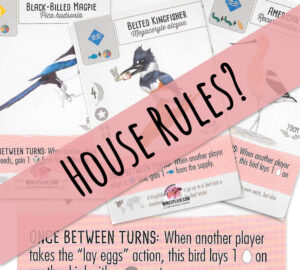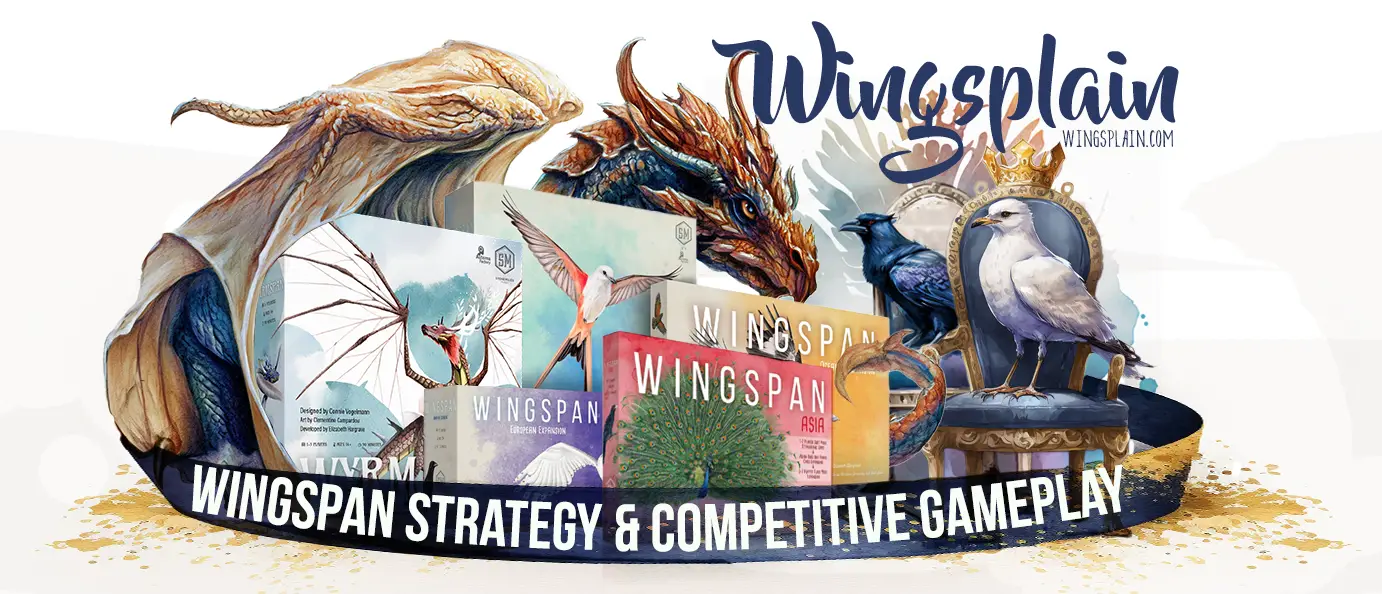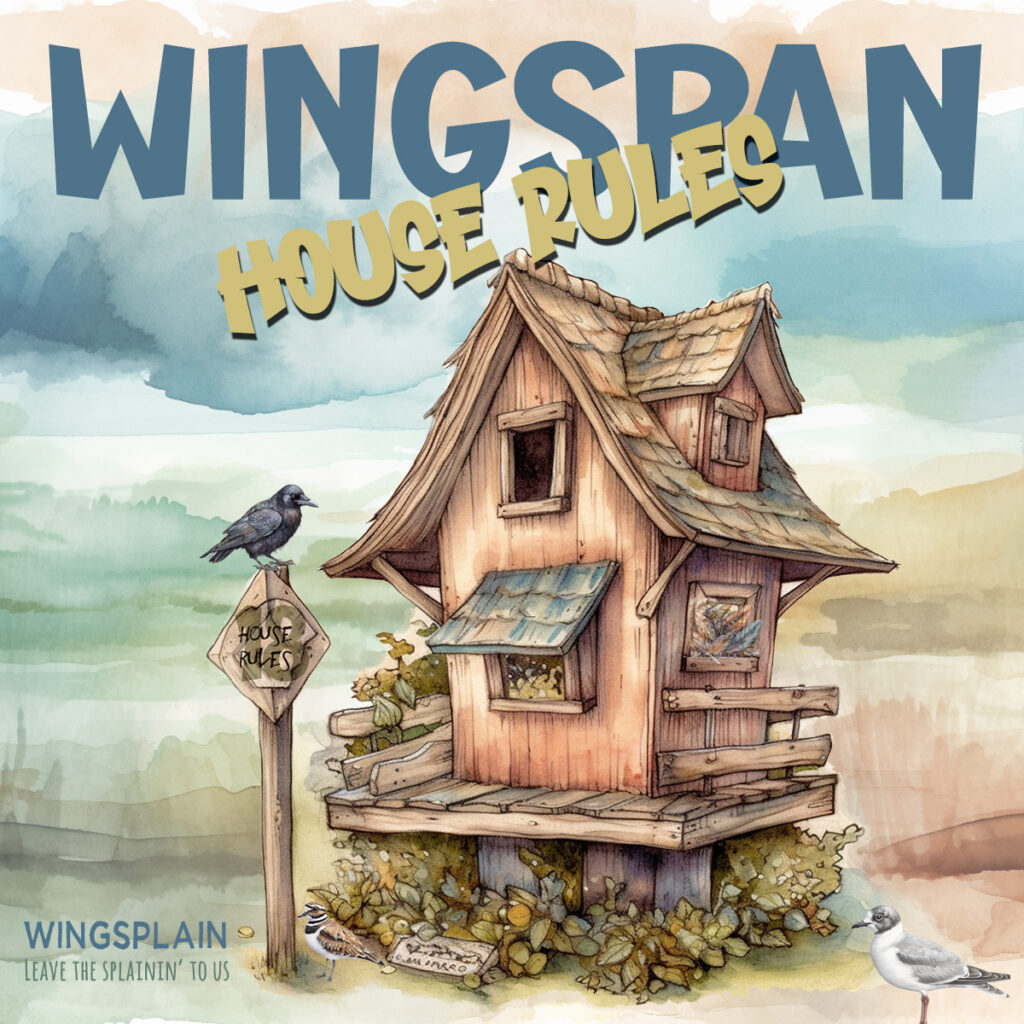Wingspan has captured the hearts of board game enthusiasts worldwide thanks to its unique blend of engaging gameplay, stunning artwork, and fascinating bird facts. But, as with any game, even the most ardent fans might crave a little extra variety after countless play sessions. That’s where Wingspan house rules come in handy!
Some players don’t want to use Wingspan house rules and feel the game should be played as designed. But, for those who don’t mind shaking up their Wingspan gameplay, we’ve collected some of the most innovative, entertaining, and unusual house rules players have implemented to ruffle their Wingspan feathers.
Get ready to take your game night to new heights with these creative twists.
18 Wingspan House Rules
1. Draft Your Way to a More Strategic Game
Incorporate drafting to create a better Wingspan strategy. Draw a set number of cards, choose one to keep, and pass the remaining cards to the left. Repeat the process until all of the bird cards get distributed to players.
2. Start Strong with Extra Resources
To kick-start the game and prevent early struggles, start with all five starting cards and five resources. This jump-starts engines and provides more options for players.
3. Bigger Draw Pile
Increase card variety by including six face-up cards in the bird tray instead of three. You could also play cards directly from the bird tray to create more interesting decisions and mitigate some of the luck in drawing.
4. More Bonus Card Choices
Deal three bonus cards instead of two. Players choose one to keep and discard the rest.
5. End-Game Scoring Twist
Score leftover resources and in-hand cards at half a VP each to encourage diverse end-game strategies.
6. Egg-Laying Dice Roll
Use dice for laying eggs instead of following the original rules. This modifies the egg-laying action with a dice roll to determine the number of eggs a player can lay on a turn. Instead of using the standard egg-laying action, players roll a die to decide the number of eggs they can place.
Dice are not used for laying eggs granted by bird-card abilities, though.
7. Longer Gameplay Options
A standard game of Wingspan has 26 activations spread across four rounds. Sometimes it can feel like you’re a round short in getting that awesome engine maxed out.
You could increase the game length by extending the number of activations or adding a 5th round. Fellow Wingspan players suggest experimenting with 30, 32, or 34 to find the perfect game duration.
8. Remove or Delay Playing the “Power Four”
Some players remove cards like Common Raven, Chihuahuan Raven, Killdeer, and Franklin’s Gull (known as the “Power Four“) to change the game dynamics. Still, others set a house rule where players have to wait until round 2 to play one of these bird cards. This is one of the Wingspan house rules that competitive players use.
9. Drafting Starting Cards: Mulligan Mechanics
Use a mulligan mechanic to draw a set number of cards, return some to the deck, and draw replacements. It gives players a chance to draw a better opening hand before starting the game—for example, experiment with drawing up to 10 cards and keeping five.
10. Balancing Pink Cards
 In Wingspan, pink-powered bird cards have abilities that trigger once between each of your turns when another player takes a specific action. In games with more players, pink abilities tend to activate more often, making them potentially more powerful than in two-player games.
In Wingspan, pink-powered bird cards have abilities that trigger once between each of your turns when another player takes a specific action. In games with more players, pink abilities tend to activate more often, making them potentially more powerful than in two-player games.
Because of this, some players think pink cards are overpowered in 4-5 player games. They choose to balance this with various house rules, such as:
- Increasing the cost of pink cards: Make pink cards more expensive to play by requiring extra resources (e.g., food tokens or eggs) to put them into play. This increased cost compensates for their potential advantage in 4-5 player games.
- Limiting the number of activations per round: Set a limit on how many times pink abilities are triggered each round. For example, a pink power card’s ability might only be allowed to activate once or twice per round, regardless of how many opportunities it actually has to trigger.
11. The Great Resource Swap
In the spirit of cooperation, this house rule allows players to trade food tokens or eggs with each other once per round. At any time during a player’s turn, they can propose a trade with another player, offering any number of food tokens in exchange for an equal number of food tokens or food tokens for eggs and vice versa.
This Wingspan house rule can create interesting alliances and rivalries as players negotiate and strategize to make the best use of their resources. Just be sure to keep an eye on your opponents, as they might be planning a sneaky food swap to get ahead.
12. Nesting Neighbors
Players can place bird cards in other players’ habitats if the habitat has an available slot. The player who places the bird card can use the “when played” and “when activated” powers, but the eggs and bonus points from that bird card belong to the habitat’s owner.
13. The Early Bird Gets the Worm
Here’s a Wingspan house rule that incentivizes players to wake up early in the bird world. The first player to play a bird card in each round gets a bonus worm (invertebrate food token). It’s a small reward that encourages players to plan their moves more strategically while adding a bit of friendly competition.
14. Feathered Friends Forever
Birds of a feather flock together, right? In this house rule, players get a bonus point for each adjacent bird card in each habitat (Forest, Grasslands, Wetlands) that shares the same bird type (e.g., waterfowl, raptors, or passerines) as the bird they just played.
It encourages players to build thematic habitats and focus on specific bird types, which can lead to some exciting and diverse Wingspan strategies.
15. Migratory Madness
Why should birds be confined to one habitat? In this house rule, players can move their bird cards between habitats once per round. This simple rule adds a layer of strategy and flexibility to the game, allowing players to optimize their habitats and adapt their strategy on the fly (pun intended!).
16. The Nest Egg
For those looking to ramp up the risk and reward factor, the nest egg house rule has each player placing food tokens from the supply on bird cards in their hand at the end of each round. If a player manages to play a bird card with food tokens on it, they get to keep the tokens as a bonus.
17. Adaptive Evolution
To add a touch of unpredictability, the adaptive evolution Wingspan house rule lets players change one of their bird’s abilities at the start of each round. Choose a bird card from the bird tray and swap its power with one of your birds in play.
This alternative rule can lead to some wild and surprising combos, keeping the game fresh and exciting.
18. Friendly Flocks
Birds often cooperate in the wild, so why not bring that camaraderie to your game? With this Wingspan house rule, whenever a player activates a “when activated” power on one of their bird cards, the players to their immediate left and/or right can also activate the same power on one of their birds if they have a “matching bird.” You decide on the criteria for “matching.”
Wrapping it Up
These Wingspan house rules add variety and customization to Wingspan gameplay. They’re perfect for the Wingspan player craving more variety, ensuring every game night remains fresh and engaging. Some of them are also a great option to incorporate when playing with children.
Don’t forget to bookmark this page so you can try them out, mix and match, and find the perfect combination to elevate your Wingspan experience!
Have a Wingspan house rule that we didn’t mention? Please share in the comments below.




Here is an idea inspired as I was reading this page (so, yet untested):
If you have ever played Puerto Rico, you know that actions left undrafted become more attractive over time as they gain a coin incentive for each round they are passed over. So – every time a player takes the Wetlands action, any birds that are still left in the tray at the end of the turn (before refilling empty slots) are “amped up” with an incentive item left on them. It could be an egg, or a food for going in your supply (esp. nectar if Oceania), or something else.
Great set of rules, certainly going to try some of them!
A minor point of uncertainty from my end: I’m not sure what the red ability fuss is about. The card activates only once between your turns, so it is rather underwhelming for a 2 player game. But once more players join in they become more like normal cards ie activate every round. From the description I seem to get the idea that you allow them to act every time they get triggered?
Another house rule we use at home:
We use 3 food dies from Oceania and 2 from the base game. We always play with all expansions and this changes the dynamic from purely nectar driven to a more balanced approach. If you want to tech into nectar, better invest in your forest and create reroll opportunities. In the Oceania expansion we rarely feel the need to take resources other than nectar, which feels detrimental for the overall gameplay to us.
We draw 6 bird cards to start and begin the game with one bird card on the board for free.
You have to follow placement rules and if it’s a “when played” power, do it after you’ve chosen what 5 cards/food tokens and bonus card you want to keep.
I find it is more fun to start with a bird in play that you didn’t have to pay for.
Most of the other house rules I would like to try!
The ravens have to draw the 2 foods from the birdfeeder instead of the supply.
This reduces the advantage of the ravens slightly.
Since we only ever play the two player game, it prevents the bird feeder from getting stuck with undesirable cubes, because the player with the raven is not using the bird feeder as a source of food.